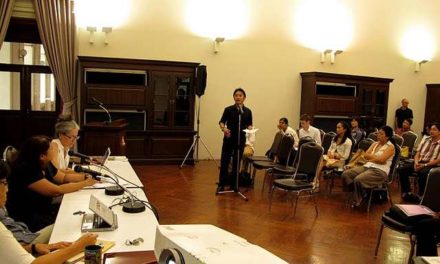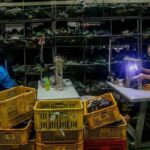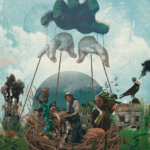By Shalmali Guttal
On June 26, 2001, almost a thousand residents from Klong Daan, Song Klong and neighboring communities gathered at the construction base of the outfall pipeline of the Samut Prakarn Wastewater Treatment Plant in the Gulf of Thailand. Spread over a hundred boats and supported by Thai and international activists from several organisations, local residents planted flags around the construction area with messages that demanded a stop to the project. Using the flags as posts, they then fenced the construction area with yellow hazard tape and declared the area an environmental crime scene. According to Ms. Dawan Chantarahassadi from Klong Daan, the action was intended to remind the Thai and international public of the destructive impacts of the Waste Water Plant on marine life and environment, the livelihoods of communities in the project area, and to future sources of seafood in Thailand.
Financed through loans by the Asian Development Bank (ADB) and the Japanese Bank for International Cooperation (JBIC), the Samut Prakarn Wastewater Treatment Plant is one of the most controversial projects in recent years in Thailand. It is an example of some of the worst practices in environmental management, project assessment and design, governance, public participation and mitigation of negative impacts. Located in Klong Daan village at the head of the Gulf of Thailand, the plant will treat wastewater from over 3,600 factories and many households in Samut Prakarn province that are located quite far away from the treatment plant. The plant will release toxic sludge and heavy water into the surrounding land, canals and the Gulf of Thailand, thus threatening the area with serious environmental contamination.
Project development has proceeded without local participation, or focused, site-specific environmental, social and economic impact assessments. Local residents and independent researchers have gathered considerable data to justify serious allegations of corruption, collusion, conflicts of interest and even malpractice in the project approval and development processes. The project was re-sited from an earlier location (closer to the polluting industries) to its present location on the grounds that the new location was more appropriate. The relocation was accompanied by a change in project design and a doubling of the project budget from 13,612 million Baht in October, 1995 to 22,995 million Baht in March, 1997. Land for the project was purchased at the new location at a highly inflated price. Not surprisingly, a number of consulting firms, private contractors, realtors and brokers have profited enormously from the project’s overflowing coffers.
Not everyone in the area, however, is likely to benefit in quite the same way. For local residents, the project almost guarantees the destruction of the marine resource base on which their livelihoods depend, and threatens their air, land and freshwater with toxic contamination. Experts appointed by the ADB and the Thai Government insist that the Klong Daan area is already dirty and that the project will actually contribute towards environmental clean up. However, they seem to overlook the fact that there is a big difference between household waste and toxic pollution, and that the two cannot be treated in the same way. The local environment in the Klong Daan area may have a waste management problem, but unlike the province’s industrial areas, it is not contaminated with chemical pollutants and toxins.
Studies conducted by local residents and independent researchers including Greenpeace show that the dilution of industrial with domestic waste does not effectively address the problems of industrial waste disposal. The Samut Prakarn plant has no system to separate the different types of waste it will receive, or to separate toxic from non-toxic sludge. All it will do is move persistent chemical pollutants from their source-where they should be treated-to an ecologically diverse and abundant environment, which in turn will be threatened by the disposal of so-called treated waste. According to Tara Buakamsri from Greenpeace Southeast Asia, “Treated water does not mean clean or non-toxic water; the sludge, volatile emissions from the plant, everything will go everywhere.” A more sustainable and effective approach would be to encourage industries to invest in cleaner production technologies and treat waste and effluents at the locations where they are produced.
Despite its claims of greater transparency, public participation and responsiveness in decision making about projects, the ADB has been particularly intractable regarding its position on the Samut Prakarn Wastewater Plant. Senior Bank management and staff maintain that their own assessments show no long-term, negative environmental, economic, or social impacts from the project. But the studies on which they base their decisions have not been publicly available, at least not to local residents who will bear the brunt of the project’s negative impacts. An ADB appointed independent review team recently gave the project a green light, thus fueling the Bank’s assertions that the project would yield net benefits to the people of the province. According to local residents, however, members of the review team did not visit the Klong Daan area even once during the review process and based their conclusions on studies already conducted by past ADB and Government appointed consultants. Also, the team leader refused to provide local residents with past studies, particulars of the consultants involved in these studies, or even the final terms of reference for their own work. Not surprisingly, local residents have completely rejected the conclusions of the review process and have challenged the independence of a review team appointed and paid for by the project’s proponents.
In the meantime, construction on the project continues without appropriate environmental, social and economic mitigation plans, or even buy-in from the industries whose waste the Plant is expected to clean up. The next stage in the battle for truth will be an investigation by an Inspection Panel approved by the ADB’s Board of Directors. Local residents ask that all loan disbursements and construction be frozen during the Panel’s investigation process, and that local residents’ inputs be fully incorporated into the Terms of Reference for the Inspection Panel’s work. However, given the autocratic and inflexible nature of its institutional structures, the ADB is hardly likely to acquiesce to these requests.
The Samut Prakarn project stands as a testimony to the internal contradictions and double standards of the ADB as both a bank, and as a development institution. Despite volumes of rhetoric on good governance, the ADB has not addressed the conflicts of interest and collusion surrounding decision making about the project, from appraisal to procurement to budgeting. Local residents have shown how the project violates at least 15 of the Bank’s own policies regarding such diverse issues as the environment, fisheries, incorporation of social dimensions in the Bank’s operations, anti-corruption, etc. They have asked for honest dialogue with the Bank’s leadership about the project, but have instead been rewarded with lies and counter attacks by both Bank, and government staff.
As this latest action showed, local residents will continue to oppose the project on grounds that cannot be substantively or ethically challenged by project proponents. The challenge for the ADB now is to have the courage to confront the truth about one of the greatest boondoggles that it is helping to perpetuate.







